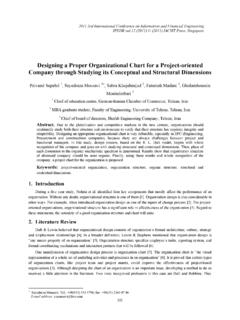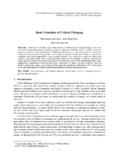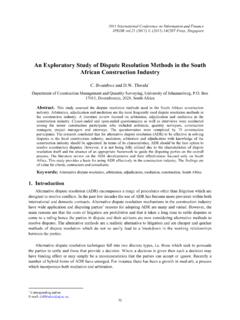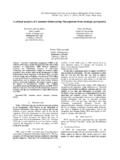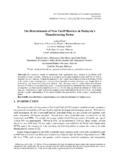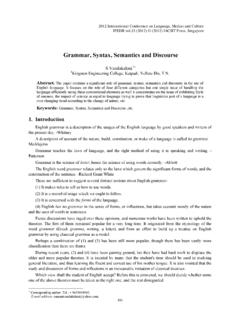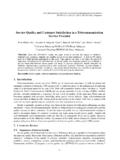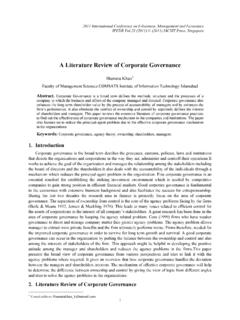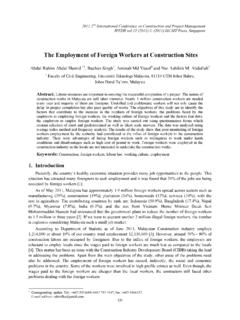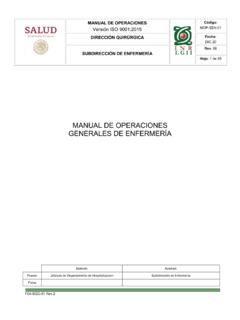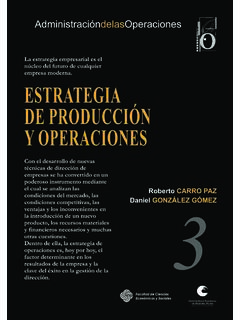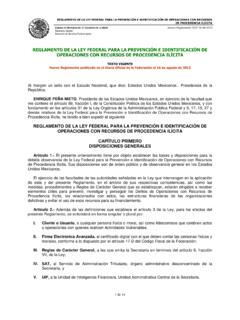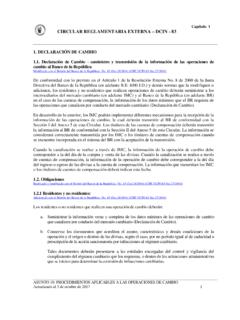Transcription of Operations Management as Practice of …
1 Operations Management as Practice of Organizations' strategic Management in Relation to the Environment Petra Horv thov +, Marcela Davidov V B Technical University of Ostrava, Faculty of Economics, Department of Management , Czech Republic Abstract. The paper is concerned with the use of Operations Management as an instrument of successful reaching the required strategic Management objectives of organizations in relation to the environment. The essence of Operations Management , manager's role and tasks are described in the paper as well as particular fields of Operations Management and applied methods. The paper points out that the organizations striving for fulfilment of their strategic plans should become well acquainted with the procedures and methods of Operations Management and use them to a considerable extent in Practice . Keywords: strategic Management , Operations Management , transformation process, inputs, outputs, operation, Operations system, Operations manager, methods of Operations Management 1.
2 Introduction The Operations Management is now one of the most asked disciplines in various organisations. These dynamic days, methods and procedures of this approach react appropriately to every change occurring both in the external and internal environment of the organization and thus they foster the reaching of required strategic objectives of business enterprise, which is the maximization of market value, competitiveness maintaining or increasing, profitability, or, possibly, just a simple survival of the organization (Hr zov , 1999). The use of the Operations Management includes a lot of heterogeneous activities, which must be achieve not only effectively but also efficiently. At the same moment must not be damaged and distressed the environment. How demanding is the environmental protection attached to such complex activity as Operations Management certainly is, very precisely describes the description of substantiality and methods of Operations Management .
3 2. Essence of Operations Management The main field which Operations Management is concentrated on is managing the sources directly taking share in product manufacturing or providing a service by the organization , achieving the strategic goals of the organizations. Sources are usually represented by people, materials, technologies and information. They are combined together by a number of processes in order to be used for acquiring an organization primary service or a product. Operations Management can be then understood as a transformation process in which inputs (resources) are by means of this process transformed into outputs (products or services). There are two categories of inputs. Resources such as information and materials, the state of which changes as a consequence of the process of conversion are called transformed resources. On the contrary, inputs such as employees, equipment and buildings that help the transformation process but their state does not change as a consequence of the conversion process are called transforming resources (Slack et al.)
4 , 2004). The process of + Corresponding author. Tel.: + 420 59 6992442; fax: + 420 59 6110026. E-mail address: 82011 International Conference on Financial Management and Economics IPEDR (2011) (2011)IACSIT Press, Singapore transformation includes a draft of Operations system, planning and control, and improvement activities that are necessary for production and providing of goods and services to customers. Products and services are outputs the purpose of which is to satisfy customers' requirements and operation, and to achieve strategic business objectives so that the organization would be continuously able to compete on the market. Certainly the whole transformation process must be achieved with regard to the environment. Operations Management as a transformation process is depicted in the following scheme. Fig. 1: The transformation process (Galloway et al.
5 , 2005) 3. Methods used by Operations Management Operations managers deal with two basic fields of activities. The first range of tasks to be solved is a design of Operations system, the second one is then planning and control of Operations (Dilworth, 1992). The first field of Operations Management , the field of design of Operations system includes in itself a large number of tasks and activities. One of the very important decisions that are part of organization 's strategy and whose wrong implementation can influence its competitiveness, costs, sales and profit is a decision on facility location for manufacturing or services. Factors influencing the decision on facility location are of three types. The first type are market-related factors - demand and competition location, the second are tangible cost factors - transport, utilities, labor force, taxes, local costs, costs of building.
6 The third type are intangible factors - the local attitude to industry, town planning division and legal regulations, space for growth, climate, schools, hospitals, recreation facilities. Management making decisions on the facility location has to pay a considerable attention to all these factors because they are rather difficult to modify, and the decision on a change will entail high costs. At making decisions on the location it is possible to use such methods as a cost-profit-volume analysis, point rating, linear programming and computer simulation. The subsequent task in the field of Operations system design is a decision on facility layout and operation process layout. Different Operations , various conditions and objectives call for alternative ways of process layout. In dependency on volume/variation there are five generally spread types of process layout: job/project, batch, flow/mass production, group technology, and continuous process.
7 For the solution of 9problems connected with the facility layout are often used heuristic programs such as CRAFT, ALDEP, CORELAP and PREP. Important and integral part of Operations system is technology. Its application in consistency with human handling can become an organization 's competitive advantage. Also in the field of services there are efforts to provide customers with better services and to increase competitiveness of organizations. By computer processed information and office work automation have considerably improved conducting clerical Operations . No less important task in the field of Operations system design is work design, which includes not only its careful laying out but also a consideration of needs of both employees performing a certain job and organization ' needs. The last field of Operations system design is work measurement, which means the determination of standard time - the time that a qualified employee working at a normal speed needs in order to fulfill a given task.
8 The second sphere of Operations Management is an important Management activity - planning and controlling Operations . It is a generally accepted fact that it is sufficient when people are continuously busy with their tasks. If the plan is bad then even if it is perfectly and effectively performed it cannot lead to fulfilling the organizations objectives. It is important for people to be lead by the plan that will reach required short term as well as long term objectives of the organization . Another important element is planning of manufacturing Operations . First, it is necessary to develop a plan ensuring sufficient capacities and only then the organization can arrange for supplies because capacity is less flexible than material supplies. Also material Management is very important in the process of planning and Operations control. Therefore even the smallest organization has to know how to manage its supply chain if it wants to be successful.
9 It means to control supplies of material flow starting their purchase and internal check through planning and manufacturing process control up to the storage and distribution of end product. Effective material Management should result in having the right things at the right time there where they are needed. This can be reached in two ways, either to have surplus of things that are needed or by the synchronization of material flow from suppliers to customers with no unjustified delays or costs. More effective is the second variant since the organization does not need to pay for surplus inventory. This can be helped, for example, by the effective system of storage, just-in-time manufacturing, by the right decision whether it is more advantageous to produce material or to ask for its supply. The following step is Management of independent-demand inventories. These are actually end products in stock that are important for many firms because they help react quickly to customers requirements.
10 At keeping inventories it is essential to determinate what their size should be and how high the costs of storage are optimum. Increase in inventories raises certain costs but decreases others, and further stocks can remain unchanged. That is why it is necessary to determine the right size and frequency of supplies, which will maintain inventories at the optimum level. Very important is also Management of dependent-demand inventories. It concerns the items to be further processed or put together or, as the case maybe, they become an inventory independent on demand. The scope of demand can be determined if the company finds out how many end products is required and according to this it will determine how many particular dependent items will be needed. Some items can be managed in the same way as independent-demand inventory because they are constantly used up in manufacturing. Others must be managed with the help of material requirements planning system (MRP system, Closed Loop MRP, MRP II).
